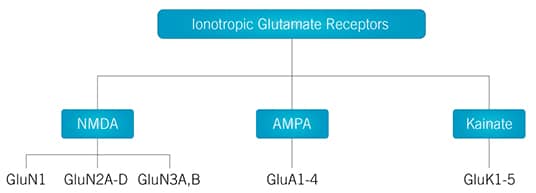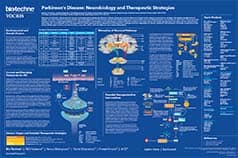Glutamate (Ionotropic) Receptors
NMDA, AMPA and Kainate receptors are members of the ionotropic class of glutamate receptors. This heterogeneous group of ion channels exist as cation-selective tetramers formed by homo- and hetero-oligomeric assembly of subunits. Common structural features include an extracellular N'-terminal, three transmembrane domains, a channel lining re-entrant 'p-loop' and an intracellular C'-terminal.
Related Targets
Ionotropic glutamate receptors represent the major excitatory neurotransmitter pathway in the brain and consequently, they are essential for normal CNS function. However, they are also implicated in numerous pathologies including Alzheimer's disease, stroke, schizophrenia, Parkinson's disease, motor neuron disease and depression.
Receptor Classification

Literature for Glutamate (Ionotropic) Receptors
Tocris offers the following scientific literature for Glutamate (Ionotropic) Receptors to showcase our products. We invite you to request* your copy today!
*Please note that Tocris will only send literature to established scientific business / institute addresses.
Huntington's Disease Research Product Guide
This product guide provides a background to Huntington's disease research and lists around 100 products for the study of:
- Somatic Instability
- Proteolysis and Inclusion Bodies
- Transcriptional Dysregulation
- Mitochondrial Dysfunction
- Nuclear-Cytoplasmic Transport Interference
- Excitotoxicity
- Stem Cells
Addiction Poster
The key feature of drug addiction is the inability to stop using a drug despite clear evidence of harm. This poster describes the brain circuits associated with addiction, and provides an overview of the main classes of addictive drugs and the neurotransmitter systems that they target.
Depression Poster
Major depressive disorder is characterized by depressed mood and a loss of interest and/or pleasure. Updated in 2015 this poster highlights presynaptic and postsynaptic targets for the potential treatment of major depressive disorder, as well as outlining the pharmacology of currently approved antidepressant drugs.
Parkinson's Disease Poster
Parkinson's disease (PD) causes chronic disability and is the second most common neurodegenerative condition. This poster outlines the neurobiology of the disease, as well as highlighting current therapeutic treatments for symptomatic PD, and emerging therapeutic strategies to delay PD onset and progression.



